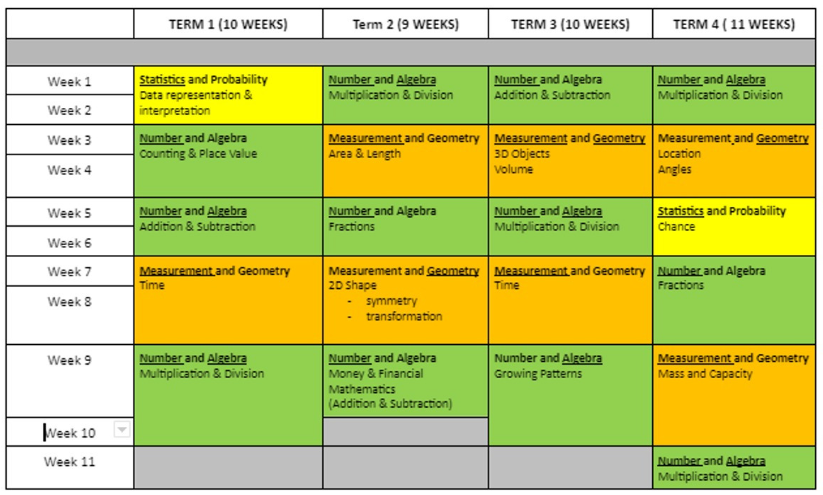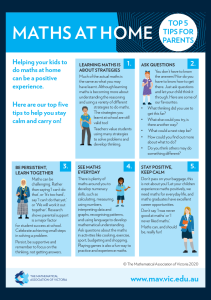In this post, we’ll give you a glimpse into the structured world of Mathematics at our school and shed light on how we plan our lessons with the help of valuable data. Our dedicated teachers meticulously plan the Maths curriculum by following a yearly overview based on the Victorian Curriculum. But that’s just the beginning. Prior to each Maths unit, we administer pre-assessments to identify areas where students need support. This data-driven approach allows our level teaching teams to facilitate targeted planning sessions, where they delve into the intricacies of the curriculum, set learning intentions and success criteria, address common misconceptions, and analyse the pre-assessment results. Through this comprehensive planning process, we ensure that our teaching aligns with student needs. Data plays a pivotal role in informing our teaching practices, and we value the insights gained from pre-and post-assessments, as they guide us in assessing our students’ growth and fine-tuning our instruction. Our commitment to data literacy empowers us to continuously enhance our teaching strategies. So, let’s explore the exciting journey of Mathematics at St Mary’s, where structured planning and data are the keys to unlocking mathematical success!
How is Maths planned?
To determine what will be taught and when over the year, our teachers work off a yearly overview that they put together at the end of the previous year. The yearly overview includes all the maths curriculum for the particular level that is required to be taught from the Victorian Curriculum.

Prior to a Maths unit, students complete a pre-assessment which is administered to determine where the points of need are within the upcoming unit; results of the pre-assessment are collated. Our level teaching teams then work through a process of facilitated planning each fortnight to plan for a Maths unit. The process of facilitated planning involves:
- Referring to the Victorian Curriculum and associated VCAA Numeracy Learning Progressions to identify what we want the students to learn
- Develop learning intentions and success criteria
- Identify common misconceptions
- Analysing the pre-assessment
- Considering the task types that will best address the learning intentions
- Considering how tasks might be differentiated to engage students
- Identifying a range of assessment opportunities to inform the teaching plan and growth of students throughout the unit of learning.
As you can see, there is a lot involved in the process of preparing a maths unit, and data is the main driver informing teachers of what to teach. We highly value the data that comes from the pre-and post-assessments, and it is an informative and reflective tool for our teaching and student growth. Data has been an ongoing focus with our teachers over many years, and we are continually building our capacity to be data literate.
Included below is an image of pre and post-assessment data from a level’s recent multiplication unit. This is a strong example of the teachers explicitly following our process of assessment, data analysis and targeted teaching.


What does a typical Maths lesson look like?
Our Maths lessons follow a consistent structure across the school, from Foundation to Year 6. Each lesson will focus on a mental strategy, and students will be engaged in a learning task, such as a game, to develop their confidence in the specific mental strategy of the week. Following this, students will begin to engage in the concept of focus in the outlined structure:
Tuning in/Explicit Teaching
Teachers explicitly teach students the content they need to engage in the lesson and solve the problem or task. It is also a time to clarify goals and expectations.
Active Learning
This is where students work individually or in small groups to solve the problem or complete a task. This is the students’ chance “to get messy with the maths.” The teacher facilitates and supports students in their thinking and mathematical approaches to assess students’ reasoning and problem-solving approaches. This is the opportunity for teachers to further extend or support students through questioning and modelling, working at a student’s point of need.
Reflection
An opportunity in the lesson for students to reflect on their learning, in particular in reference to the success criteria of the lesson. Students are guided to share big ideas and to make sure that they have understood the mathematics. Reflection also allows teachers to assess how well students are progressing toward the goals of the lesson. Teachers use the discussion to determine whether additional teaching and/or additional exploration by students is needed before they go on to the next lessons.
To support our families, we would like to share a valuable resource from the Mathematics Association of Victoria. Their Maths At Home poster outlines the top 5 tips for parents to enhance their child’s mathematical journey. By incorporating these tips into your daily routines and conversations, you can create a supportive atmosphere that nurtures a love for Mathematics and reinforces learning beyond the school walls.

We hope this blog has provided you with valuable insights into the extensive planning process our teachers undertake to develop and implement Mathematics units at St Mary’s Primary School. From the yearly overview that sets the curriculum framework to the pre-assessments that guide our teaching focus, we are dedicated to ensuring our instruction meets the specific needs of our students. Data plays a vital role in informing our decisions, and we value its power in driving our teaching practices. As we continue to prioritise data literacy, we strive to enhance our teaching strategies and support our student’s growth. At St Mary’s, structured planning and data are the keys to unlocking mathematical success.
Lucy McGrath
Leader of Mathematics
